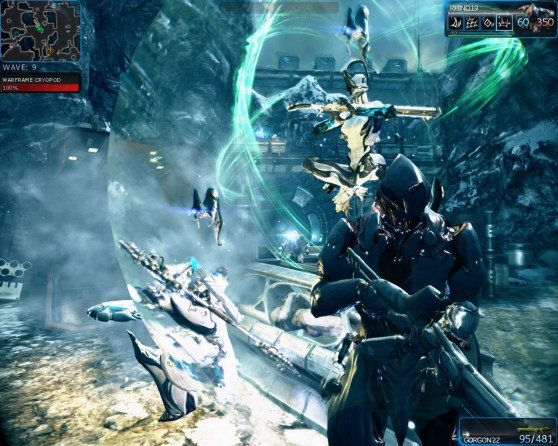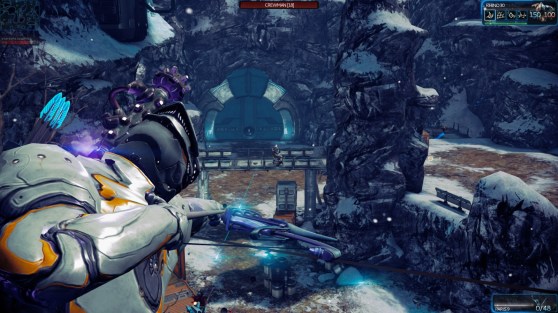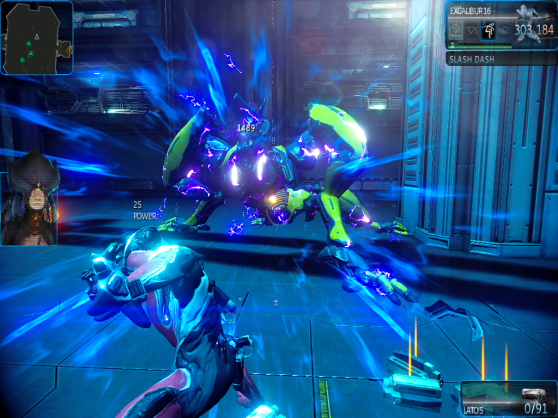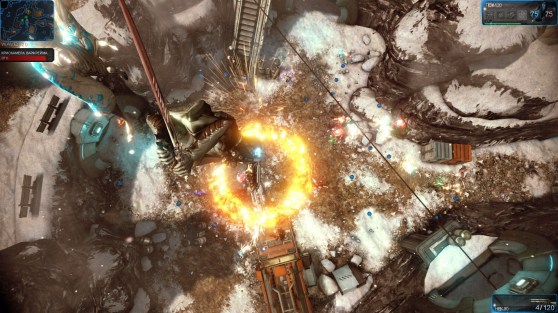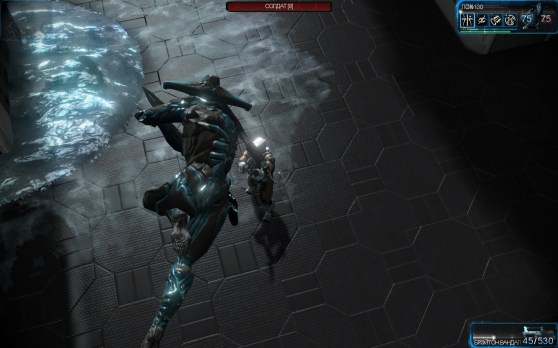Warframe has been a long time coming. The ambitious, free-to-play cooperative action game is the dream project of independent developer Digital Extremes, the studio behind titles such as The Darkness II, several entries in the Unreal Tournament franchise, and 2008’s highly underrated Dark Sector.
It’s the latter game that Warframe is so heavily based upon — or more appropriately, Dark Sector was based on a sliver of the concept that would eventually become Warframe, as creative director Steve Sinclair explains below. Warframe entered open beta on March 21 and has exceeded over 1 million players, rapidly climbing the ranks of popular game-tracking and social networking site Raptr.
Warframe uses premium Kickstarter-esque “founders packages” along with sales of Platinum, the in-game currency, to help fund its ongoing development. Awhile back, GamesBeat spoke with Sinclair about the game’s storied past, its monetization efforts, and the future plans for this potentially “endless” endeavor.
GamesBeat: Can you tell how Warframe came about? I understand it goes as far back as Dark Sector?
Steven Sinclair: It’s a long story. Most of it is boring and filled with naivety and hubris. We dreamed big and started building a next-gen engine before the Xbox 360 and PlayStation 3 were announced. Crazy ideas, like Arthur C. Clarke had said: “Any sufficiently advanced technology is indistinguishable from magic.” We started building and getting people excited about the visuals and the graphics, but when we hit the road to get it published, we hit a wall. WWII shooters were what all the marketing departments wanted. Many publishers came close but ran us through the “comparables” matrix and decided that a hard sci-fi game wouldn’t sell enough.
So we shelved the sci-fi. We adapted the pitch and toned it down so the company could survive. We lost a bit of control. We lost a bit of mojo. But we were stubborn and held on to some of the ideas in a subtle way. We took the race Tenno and named Dark Sector’s hero after him. We took the technology of Warframe and made it the virus that gave him his power. Then we crunched through the years of what it actually, properly took to build a game engine and a game from scratch, which we had completely underestimated. Then we shipped it just as it was getting a life of its own — before it was perfect. Despite its flaws, I appreciate you calling it underrated: I am still very proud of what we accomplished. I loved the Glaive. I loved how the powers evolve. But it was a death march to get it out, and my story for it sucked.
Years go by, and we make more and more awesome stuff. The Darkness II was incredible, a fantastic story with a great noir style. The Demon Arms are endless fun. We have Star Trek very near to ship, and it’s amazing to see Kirk and Spock both in terms of personality and as contrasting play-styles. The stealth/action choices the team built have brought a systemic depth to the game that will surprise people.
Now we are faced with new projects and what the future of the company is and where the industry is going. James built this company on shareware and saw the growing free-to-play market as getting back to our roots. The model is very much getting back to making a game that ships directly to customers that we have more ownership over and [more] interaction with our gamers. So we looked around at what ideas we had and decided that the sci-fi Dark Sector concepts would be a way to hit the ground running. It was time to make the game we always wanted to and to do it on our terms. Time to finish what we started back 10 years ago.
GamesBeat: Digital Extremes is no stranger to triple-A titles developed for big-name publishers. What are the specific advantages and disadvantages of doing a game like Warframe on your own versus Star Trek, The Darkness, etc.
Sinclair: Disadvantages: budget. Do-or-die stakes of self-funding. You have to do your own marketing, customer support, infrastructure — a whole new learning curve. Sacrifice established brands — or not a sequel — distribution channels and retail expertise.
Advantages: creative control — glorious creative control! More — much more — than a pittance of the profits. A chance to take risks and think differently. You can actually have an open and honest discourse with players instead of being on-message and repeating talking points — this is my favorite one.
GamesBeat: What’s your estimated goal for having the launch version of Warframe “complete” and out of beta?
Sinclair: A game like Warframe is really different for us. It’s about building a community of invested players and keeping them interested over a long period of time. This implies terms like “finished” or “complete” are a death sentence. Our dream for Warframe is that it is never complete but constantly growing and evolving. Shedding the bad stuff and adding new possibilities.
I’m hoping that Season One of Warframe kicks off this year, but we still have to face the fire of open beta.
GamesBeat: How do you go about designing the Warframes and their abilities?
Sinclair: It happens organically, which is code for chaotically. Scott McGregor, our design lead, sits next to me and writes Lua and experiments until it gets cool. We play it and iterate on it until we think it fits, and then we ship it. We don’t pretend to put [in] thousands of hours of thought or testing like our players do. They are fantastic at showing us the problems, and we try to repay them with fixing, buffing, and nerfing until it fits with the whole.
That said, there is a general design goal that is always the same: differentiation. Our ultimate goal is that if you asked the question, “Which is the best Warframe?”, everyone would have differing opinions. That is a sign we are making them diverse enough, deep enough to master.
GamesBeat: What are some things, like the wall-running and zip lines, that are still planned to be implemented?
Sinclair: With restraint, yes, though our focus is on refining those things more than adding more complexity. The problem with things like wall-running is we are forcing players to learn it too early, and we’re having to adapt tutorials and look at restricting it. We are a bit cautious of putting in the kitchen sink so we don’t explode people’s minds. [Update 7] adds more ninja stuff, though, like bullet-blocking and stealth attacks.
GamesBeat: Being both a console and PC gamer, Warframe really feels like it needs to be played with a controller. Do you have that support yet, or are you planning for it?
Sinclair: Yes, agreed. The combat works great with a controller but has problems with menu and hacking game navigation. This is a huge priority for us and will be fixed in the next major update.
GamesBeat: Are you considering putting Warframe on consoles eventually? Why or why not?
Sinclair: I wouldn’t rule it out! It would depend on retaining our rapid update schedule and maintaining control over the game’s content. I heard a lot of things in the PS4 reveal that gave me hope this may be possible and even encouraged from Sony.
GamesBeat: While the game looks great, I have to say the Warframes themselves look a little pudgy. All of mine seem to have love handles. Have you heard that feedback yet? Are the Warframe designs final?
Sinclair: Rhino definitely has some bulk to him while, on the other hand, Volt is super sleek. It really runs the gamut. We are introducing new Warframes frequently, so there is always something new to check out, and the customization options are indeed growing. We introduced Helmets in [a recent] update and will be continuing to expand this. The feedback we’ve received generally favors personalization over changing the look of the base models.
GamesBeat: The Foundry seems like a good place to make unique weapons and equipment. Can you give some tips on how and where to find blueprints?
Sinclair: Yes, the Foundry is working very well for us. It really helps us deal with accusations of pay-to-win. We do our best to ensure players that can’t afford Platinum can buy or find blueprints. Some of the coolest gear in the game is actually blueprint-only!
Best ways to get them: kill bosses. Play Alerts, which are only shown to you based on how much of the Solarchart you have unlocked, and getting lucky on the three-star daily resupply.
GamesBeat: The game seems a bit grindy. Do you see Warframe as being a game that players spend a lot of time replaying the same levels farming for resources?
Sinclair: That is the way it is right now and shows a lack of diversity in our mid/end-game, which is centered around mastering all of the Warframes and weapons. In the next update, we are smashing the systems that suck in the endgame and reimagining the framework for endgame content. Our Alerts system, which is overly crude, is part of that. My view is it can’t be one thing. It can’t be endgame equals X. Warframe will offer options. Clan meta … deeper item specialization … deeper raiding.
GamesBeat: Warframe, along with other in-development MMOs such as Firefall, has adopted a Kickstarter-inspired early monetization strategy. What has the reaction been like to that?
Sinclair: For the most part, it has been awesome. It gave us more resources — money and people — to throw at the game so we could grow it twice as fast as we expected to. People want to see the game grow and prosper part with their hard-earned money, and we in turn owe them to make their dreams come true. I wanted to really take advantage of the independent aspect of Warframe’s development — we could talk directly to players without censorship — and I think it is starting to work. Players tear us apart, and we react quick, we fix, we improve and ideally surpass expectation.
Downsides? One very interesting one is the social ramifications. Just last night, I read a forum post expressing grief about the Design Council’s sneak peek at our next update. A scathing: pay-to-know. That cuts because I have been consciously balancing our work on feedback from both supporting and free player sources. Our goal is to balance the needs of free players, who play an essential role in building a large and thriving community, while giving supporting players the value they deserve.
GamesBeat: $250 is currently the top founder package. Can you break down the percentage in which players are paying for the different founder levels?
Sinclair: I’m pretty sure I’d be shot if I gave out detailed financial information … sorry! I will say that a sizable percent of our total funding has come from Grandmasters, though, and their generosity is humbling. We owe it to them to make an incredible game.
GamesBeat: $250 is also considerably more than most players put into any game. You could buy Skyrim and all its [downloadable content] two to three times over before reaching that amount, so I was wondering how you quantify the value the player is getting with that?
Sinclair: We’re an independent studio. Warframe’s development is being paid for by DE. Now that we have Founders — and players purchasing Platinum — the players have brought a surge of investment that we are rolling into making the game amazing. As you mentioned above, the Founders program is like a mini Kickstarter campaign. On the high end, you get a virtual seat on the Design Council — where you see how the sausage is made and give input on upcoming features — and kick-ass exclusive gear. All levels include a truckload of Platinum to purchase whatever you want in the game. From the feedback we’ve received, a lot of people want to invest in the game above the typical console game price because they believe in it and want to do their part to see it succeed … and it’s working.
[All screenshots: Warframe website]
VentureBeat's mission is to be a digital town square for technical decision-makers to gain knowledge about transformative enterprise technology and transact. Learn More
